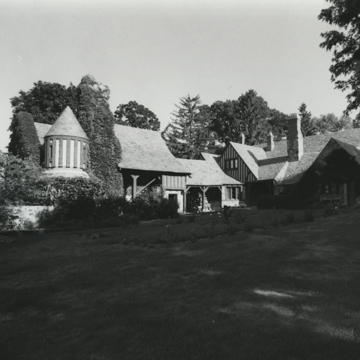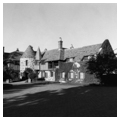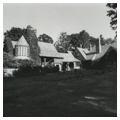Frank was locally renowned for creating movie palaces that evoked exotic foreign locales. In this vein, he created an estate for industrialist Walter Lindsay and his wife Catherine that suggested medieval Normandy. During the 1920s, the nouveaux riche favored houses that could be associated with European landowners as a way of articulating their newfound class status. The sculptural design is at once stately and folksy. The house’s two-story front is replete with medieval references. Fieldstone clads the lower walls, and false half-timbering marks the upper story, where ersatz brick nogging interrupts the stucco infill, enhancing the period flavor. Near one end of the building, where a small ell makes its turn, a squat two-story flagstone tower with a conical roof is next to an elongated pyramidal roof and an oriel. The house’s L-shaped rear varies in heights and rooflines and looks like a sprawling farmhouse. Frank created the illusion that the building had been added to over the centuries by connecting the main block to the rear wing with a low breezeway and an abruptly truncated half-timbered cross-gable. This additive appearance characterized medieval buildings, many of which were erected and enlarged in stages. Frank amplified the medieval appearance by placing a large conical tower at one end, which he ringed with massive vertical timbers, and by covering the back wing with a steeply pitched roof. The adjacent gatehouse continues the French Norman theme.
You are here
Walter and Catherine Lindsay House, “Deerwood”
If SAH Archipedia has been useful to you, please consider supporting it.
SAH Archipedia tells the story of the United States through its buildings, landscapes, and cities. This freely available resource empowers the public with authoritative knowledge that deepens their understanding and appreciation of the built environment. But the Society of Architectural Historians, which created SAH Archipedia with University of Virginia Press, needs your support to maintain the high-caliber research, writing, photography, cartography, editing, design, and programming that make SAH Archipedia a trusted online resource available to all who value the history of place, heritage tourism, and learning.





